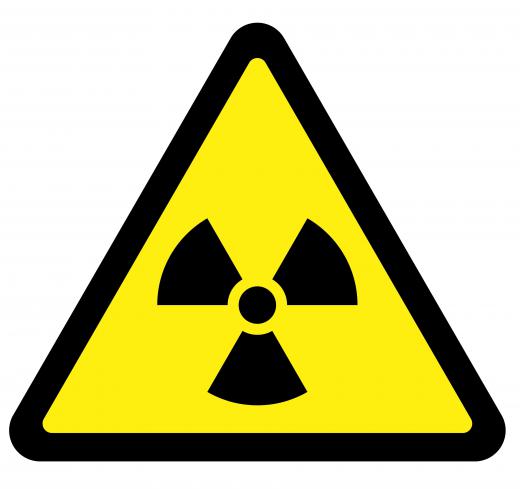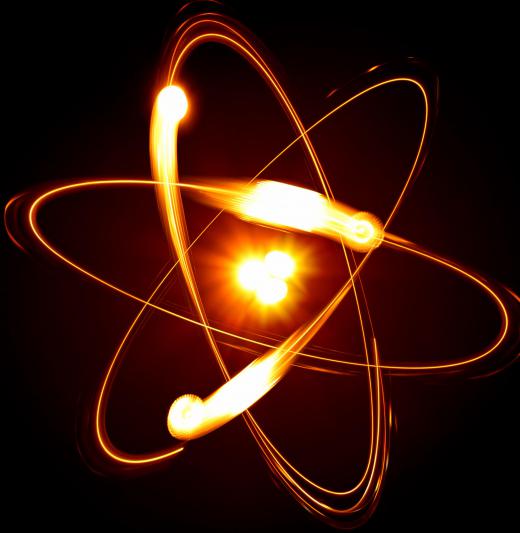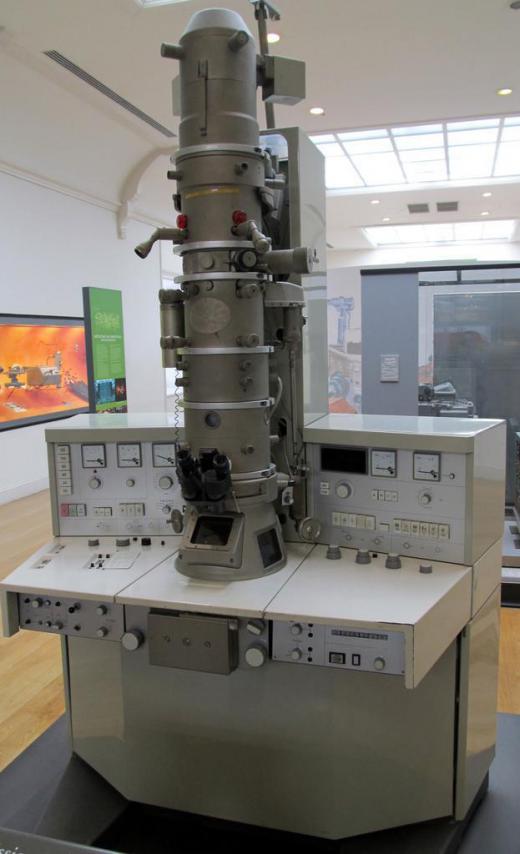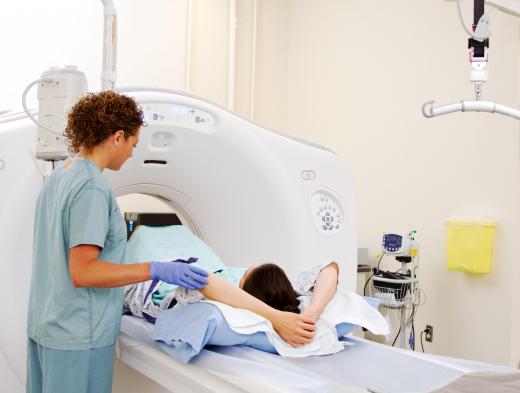What Is Radioactivity?
 Michael Anissimov
Michael Anissimov
Radioactivity is the process whereby unstable atomic nuclei release energetic subatomic particles or electromagnetic radiation (EMR). This phenomenon can cause one element to turn into another and is partly responsible for the heat of the Earth’s core. Radioactivity has a wide range of uses, including nuclear power, in medicine, and in dating organic and geological samples. It is also potentially dangerous, as high-energy particles and radiation can damage and kill cells, and alter DNA, causing cancer.
Radioactive Decay

Unstable atomic nuclei are said to decay, meaning that they lose some of their mass or energy in order to reach a more stable, lower energy, state. This process is most often seen in the heavier elements, such as uranium. None of the elements heavier than lead has any stable isotopes, but lighter elements can also exist in unstable, radioactive, forms, such as carbon-14. It is thought that heat from the decay of radioactive elements maintains the very high temperature of the Earth’s core, keeping it in a liquid state, which is essential to the maintenance of the magnetic field that shields the planet from damaging radiation.

Radioactive decay is a random process, meaning that it is physically impossible to predict whether or not a given atomic nucleus will decay and emit radiation at any given moment. Instead, it is quantified by half-life, which is the period of time it takes for half of a given sample of nuclei to decay. Half-life applies to a sample of any size, from a microscopic quantity to all the atoms of that type in the universe. Different radioactive isotopes vary widely in their half-lives, which range from a few seconds, in the case of astatine-218, to billions of years for uranium-238.
Types of Decay

To be stable, a nucleus cannot be too heavy, and needs to have the right balance of protons and neutrons. A heavy nucleus — one that has a large number of protons and neutrons — will sooner or later lose some weight, or mass, by emitting an alpha particle, which consists of two protons and two neutrons bound together. These particles have a positive electric charge, and, compared to other particles that can be emitted, are heavy and slow moving. Alpha decay in an element causes it to change into a lighter element.

Beta decay occurs when a nucleus has too many neutrons for its number of protons. In this process, a neutron, which is electrically neutral, spontaneously changes into a positively charged proton by emitting a negatively charged electron. These high-energy electrons are known as beta rays, or beta particles. Since this increases the number of protons in the nucleus, it means that the atom changes to different element with more protons.

The reverse process can occur where there are too many protons, compared to neutrons. In other words, a proton turns into a neutron by emitting a positron, which is the positively charged antiparticle of the electron. This is sometimes called positive beta decay, and results in the atom turning into an element with fewer protons. Both types of beta decay produce electrically charged particles that are very lightweight and fast.
Although these transformations release energy in the form of mass, they can also leave the remaining nucleus in an “excited” state, where it has more than its minimum amount of energy. It will therefore lose this extra energy by emitting a gamma ray — a very high frequency form of electromagnetic radiation. Gamma rays have no weight, and travel at the speed of light.
Some heavy nuclei can, instead of emitting alpha particles, actually split apart, releasing a lot of energy, a process known as nuclear fission. It can occur spontaneously in some isotopes of heavy elements, such as uranium-235. The process also releases neutrons. As well as happening spontaneously, fission can be prompted by a heavy nucleus absorbing a neutron. If enough fissionable material is brought together, a chain reaction can take place where neutrons produced by fission cause other nuclei to split, releasing more neutrons, and so on.
Uses
The best-known uses of radioactivity are perhaps in nuclear power stations and in nuclear weapons. The first atomic weapons made use of a runaway chain reaction to release a huge amount of energy in the form of intense heat, light, and ionizing radiation. Although modern nuclear weapons primarily use fusion to release energy, this is still initiated by a fission reaction. Nuclear power stations use carefully controlled fission to produce the heat to drive steam turbines that generate electricity.
In medicine, radioactivity can be used in a targeted way to destroy cancerous growths. Since it is easily detected, it is also used to trace the progress and uptake of drugs by organs, or to check that they are functioning correctly. Radioactive isotopes are often used to date samples of material. Organic substances can be dated by measuring the amount of carbon-14 they contain, while the age of a sample of rock can be determined by comparing the amounts of various radioactive isotopes present. This technique has allowed scientists to measure the age of the Earth.
Health Effects
In a health context, all emissions from decaying atomic nuclei, whether particles or EMR, tend to be described as radiation, and they are all potentially hazardous. These emissions are either ionizing in themselves or interact with matter in the body in a way that produces ionizing radiation. This means that they can remove electrons from atoms, turning them into positively charged ions. These can then react with other atoms in a molecule, or in neighboring molecules, causing chemical changes that can kill cells or cause cancer, especially if radiation has interacted with DNA.
The kind of radiation that is most dangerous to humans depends upon the circumstances in which it is encountered. Alpha particles can only travel a short distance through the air and cannot penetrate through the outer layer of skin. If they come into contact with living tissue, however, they are the most dangerous form of radiation. This can happen if something that emits alpha radiation is swallowed or inhaled.
Beta radiation can penetrate skin, but is stopped by a thin layer of metal, such as aluminum foil. Neutrons and gamma radiation are much more penetrating and thick shielding is required to protect health. Since most gamma radiation passes right through the body, it is typically less likely to cause illness at low levels, but is still a very serious hazard. If materials, including living tissue, absorb neutrons, they can become radioactive themselves.
Exposure to harmful radiation is generally measured in terms of the amount of energy absorbed by the exposed material, a measure that can be applied to all forms of radiation and all materials, although it is most commonly used in the context of human health. The SI unit for exposure is the gray, with one gray being equivalent to one joule of energy absorbed per kilogram of matter. In the USA, however, another unit — the rad, which is equivalent to 0.01 grays — is often used.
Since different types of radioactivity behave in different ways, another measurement, the sievert, is used to give a better idea of the likely health effects of a given dose. It is calculated by multiplying the dose in grays by a quality factor that is specific to the particular type of radiation. For example, the quality factor for gamma radiation is 1, but the value for alpha particles is 20. Therefore, exposure of living tissue to 0.1 grays of alpha particles would result in a dose of 2.0 sieverts, and would be expected to have twenty times the biological effect as one gray of gamma radiation. A dose of four to five sieverts, received over a short time period, carries a 50% risk of death within 30 days.
AS FEATURED ON:
AS FEATURED ON:















Discussion Comments
Who are the scientists involved in the field of radioactivity? and what are their contributions?
is radioactivity a curse or a boon?
anon162619: Check out you smoke detector, it uses trace amounts of radioactive isotope called Americium.
how is radioactivity useful for us in our daily life?
Radioactivity is a natural phenomenon that results from the the fact that, entropy increases with time, or, everything will eventually fall to pieces. The nucleus of certain atoms split apart because the repulsive force of the protons eventually overcomes the short range nuclear force.
This is more common as you generally go higher up the periodic table (which is why most elements created by man don't last long, too many protons). Yes, to a degree the human body, and all lifeforms, are radioactive. Every day, at least one atom in your body splits apart. But don't worry. You have hundreds of billions of atoms to go (if not more). It will take a very long time for your body to be reduced to sub-atomic particles (emphasis on very long).
Radioactivity is not a thing. It is the emission of particles and energy by large, unstable atoms that are seeking a more stable structure. Radiation is the "something" that unstable atoms give off as they seek stability. This can be in the form of alpha particles, beta particles or gamma "photons".
how do radioactive atoms change structure?
But how it is useful for us?
How can radioactivity be useful to us?
Is it possible for a person to be radioactive?
wasn't radioactivity created by marie curie?
In your opinion, is radioactivity a blessing or a curse?
how does radioactive material affect humans?
can salt help break down radioactive waste or help speed up the breakdown?
Why do we have it?
What does radioactivity do?
how is radioactivity formed?
how do we use radioactivity in our daily life?
how is radioactivity formed?
what are the effects of radiation in our health and environment?
Is radioactivity considered a physical characteristic?
Can a neon particle or any noble gas become radioactive?
How do we use radioactivity in our daily life?
We work with Copper Concentrate on a daily basis, with readings usually above 0.3mSv. Is this safe? Should we be concerned? What effect will this have on us?
What is the amount of ir radiation emitted by humans? And what s the amount of ir radiation emitted by dead people? What's the rate of decay?
What role did Marie Curie play in the discovery of radioactivity?
Radioactivity has a lot of applications in various fields.Could you please explain its uses in relation with carbon dating?
Is there a simpler term in meaning of the word Radioactivity. Eg. In a highschool level?
what are the medical applications of radioactivity?
is radioactivity something that can go through anything or is it something that dissolves into things?
Post your comments